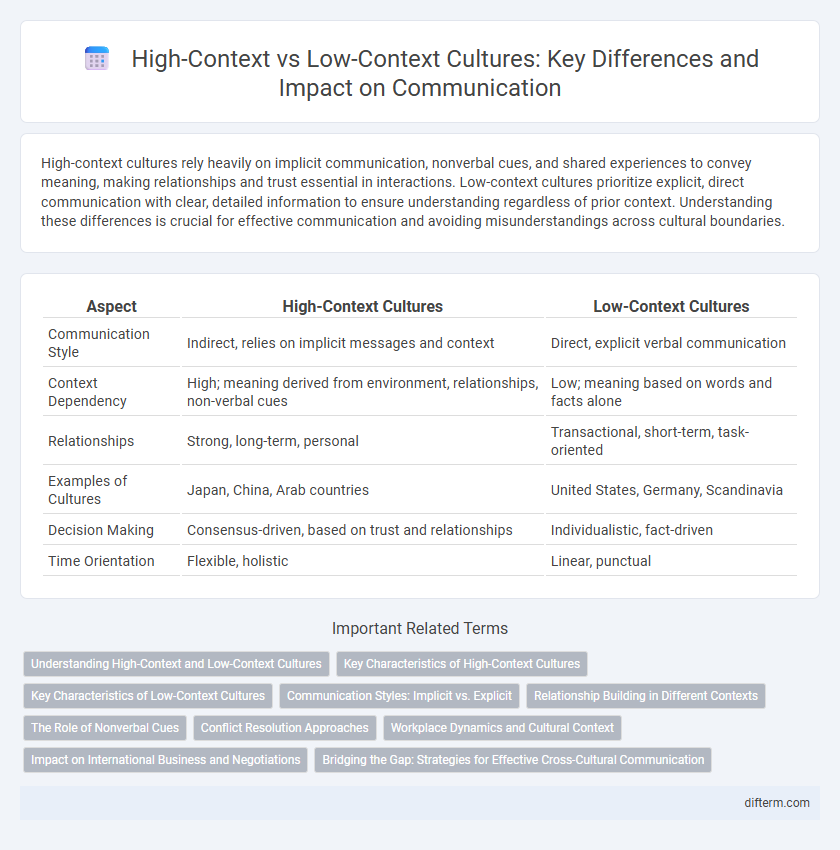High-context cultures rely heavily on implicit communication, nonverbal cues, and shared experiences to convey meaning, making relationships and trust essential in interactions. Low-context cultures prioritize explicit, direct communication with clear, detailed information to ensure understanding regardless of prior context. Understanding these differences is crucial for effective communication and avoiding misunderstandings across cultural boundaries.
Table of Comparison
| Aspect | High-Context Cultures | Low-Context Cultures |
|---|---|---|
| Communication Style | Indirect, relies on implicit messages and context | Direct, explicit verbal communication |
| Context Dependency | High; meaning derived from environment, relationships, non-verbal cues | Low; meaning based on words and facts alone |
| Relationships | Strong, long-term, personal | Transactional, short-term, task-oriented |
| Examples of Cultures | Japan, China, Arab countries | United States, Germany, Scandinavia |
| Decision Making | Consensus-driven, based on trust and relationships | Individualistic, fact-driven |
| Time Orientation | Flexible, holistic | Linear, punctual |
Understanding High-Context and Low-Context Cultures
High-context cultures rely heavily on implicit communication, non-verbal cues, and shared experiences to convey meaning, often found in societies like Japan, China, and Arab countries. Low-context cultures prioritize direct, explicit verbal communication, emphasizing clarity and detail, common in the United States, Germany, and Scandinavia. Understanding these differences enhances cross-cultural interactions by recognizing how context shapes communication styles and expectations.
Key Characteristics of High-Context Cultures
High-context cultures rely heavily on implicit communication, where nonverbal cues, shared experiences, and unspoken understandings convey meaning more than explicit words. Relationships and social hierarchies play a crucial role, with trust and long-term connections forming the basis of communication. Countries like Japan, China, and Arab nations exemplify high-context cultures, emphasizing harmony, indirectness, and group cohesion.
Key Characteristics of Low-Context Cultures
Low-context cultures prioritize explicit communication, where information is conveyed primarily through direct language and clear, detailed messages. These cultures emphasize individualism, formal rules, and written contracts to ensure understanding and reduce ambiguity. Common examples include the United States, Germany, and Scandinavian countries, where clarity and precision in communication are crucial for effective interaction.
Communication Styles: Implicit vs. Explicit
High-context cultures emphasize implicit communication where meaning is derived from context, non-verbal cues, and established relationships, often relying on shared understandings and indirect expressions. Low-context cultures prioritize explicit communication, valuing clear, direct, and unambiguous language to convey information, reducing the need for interpretation. Understanding these communication styles is crucial for effective interaction in multicultural environments, as it influences message interpretation and response strategies.
Relationship Building in Different Contexts
High-context cultures prioritize implicit communication and rely heavily on trust and long-term relationships, where nonverbal cues and shared experiences convey meaning beyond words. In contrast, low-context cultures emphasize explicit, direct communication and value clear, concise exchanges to build relationships efficiently, often in a short timeframe. Understanding these dynamics is crucial for effective cross-cultural interaction and successful relationship building in international business and social environments.
The Role of Nonverbal Cues
Nonverbal cues play a crucial role in high-context cultures where communication relies heavily on implicit messages and shared understanding, often conveyed through gestures, facial expressions, and tone of voice. In contrast, low-context cultures depend more on explicit verbal communication, making nonverbal signals less central but still important for reinforcing spoken words. Understanding these cultural differences in nonverbal communication enhances cross-cultural interactions and reduces misunderstandings.
Conflict Resolution Approaches
High-context cultures prioritize indirect communication and rely heavily on shared understanding and nonverbal cues during conflict resolution, often emphasizing harmony and relationship preservation. Low-context cultures prefer explicit communication, addressing conflicts straightforwardly through clear, direct dialogue and formal procedures. These differing approaches impact negotiation styles, decision-making, and the strategies used to restore social balance in various cultural settings.
Workplace Dynamics and Cultural Context
High-context cultures in the workplace rely heavily on implicit communication, shared values, and nonverbal cues, fostering strong interpersonal relationships and trust among team members. Low-context cultures emphasize explicit communication, clarity, and detailed instructions, prioritizing efficiency and individual accountability. Understanding these dynamics enhances cross-cultural collaboration and reduces misunderstandings in global business environments.
Impact on International Business and Negotiations
High-context cultures rely heavily on implicit communication, nonverbal cues, and established relationships, which can lead to misunderstandings in international negotiations if low-context parties expect direct dialogue. Low-context cultures emphasize explicit, clear, and detailed communication, facilitating straightforward contract terms but potentially overlooking subtleties valued by high-context counterparts. Understanding these differences enhances cross-cultural negotiation strategies, minimizes conflict, and ensures effective multinational business partnerships.
Bridging the Gap: Strategies for Effective Cross-Cultural Communication
Bridging the gap between high-context and low-context cultures requires a deep understanding of implicit and explicit communication styles to enhance cross-cultural interactions. Employing active listening, asking clarifying questions, and adapting message delivery can minimize misunderstandings and build trust. Leveraging cultural intelligence and situational awareness fosters effective communication in diverse environments.
High-context vs Low-context cultures Infographic

 difterm.com
difterm.com